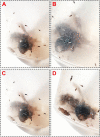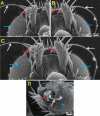Scuttle fly Megaselia scalaris (Loew) (Diptera: Phoridae) endoparasitoid as a novel biocontrol agent against adult American cockroaches (Periplaneta americana)
- PMID: 38684676
- PMCID: PMC11058772
- DOI: 10.1038/s41598-024-59547-w
Scuttle fly Megaselia scalaris (Loew) (Diptera: Phoridae) endoparasitoid as a novel biocontrol agent against adult American cockroaches (Periplaneta americana)
Abstract
The American cockroach, Periplaneta americana (Linnaeus, 1758) (Blattodea: Blattidae), is one of the most common pests that thrive in diverse environments and carries various pathogens, causing critical threats to public health and the ecosystem. We thus report in this study the first observation of decapitated American cockroaches as a result of infestation with scuttle fly parasitoids. Interestingly, behavioral alterations in the form of zombification-like behavior could be observed in cockroaches reared in the laboratory before being decapitated, implying that the insect targets cockroach heads. To identify this parasitoid, cockroaches' corpora were isolated in jars, and apodous larvae were observed. Larvae developed into small coarctate pupae, and adults emerged. The scuttle flies were collected and exhibited tiny black, brown, to yellowish bodies. The fly was initially identified based on its morphological properties as a member of the order Diptera, family Phoridae. To provide further insights into the morphological attributes of the phorid species, the fly was examined using a scanning electron microscope (SEM) and then identified as Megaselia scalaris accordingly. SEM analysis revealed the distinctive structure of M. scalaris concerning the head, mouth parts, and legs. Specifically, the mouth parts include the labrum, labellum, rostrum, and maxillary palps. Although further investigations are still required to understand the complicated relationships between M. scalaris and American cockroaches, our findings provide a prominent step in the control of American cockroaches using M. scalaris as an efficient biological control agent.
Keywords: Periplaneta americana; American cockroach; Biological control; Scanning electron microscope; Scuttle fly Megaselia scalaris; Zombification behavior.
© 2024. The Author(s).
Conflict of interest statement
The authors declare no competing interests.
Figures











Similar articles
-
Parasitism of Soldiers of the Termite, Macrotermes gilvus (Hagen), by the Scuttle Fly, Megaselia scalaris (Loew) (Diptera: Phoridae).Insects. 2020 May 21;11(5):318. doi: 10.3390/insects11050318. Insects. 2020. PMID: 32455799 Free PMC article.
-
Developmental rate, size, and sexual dimorphism of Megaselia scalaris (Loew) (Diptera: Phoridae): its possible implications in forensic entomology.Parasitol Res. 2014 Jun;113(6):2285-94. doi: 10.1007/s00436-014-3883-z. Epub 2014 Apr 12. Parasitol Res. 2014. PMID: 24728523
-
Developmental Variation of Indian Thermophilic Variety of Scuttle Fly Megaselia (Megaselia) scalaris (Loew, 1866) (Diptera: Phoridae) on Different Substrates.Scientifica (Cairo). 2016;2016:4257081. doi: 10.1155/2016/4257081. Epub 2016 Jul 4. Scientifica (Cairo). 2016. PMID: 27471604 Free PMC article.
-
Natural history of the scuttle fly, Megaselia scalaris.Annu Rev Entomol. 2008;53:39-60. doi: 10.1146/annurev.ento.53.103106.093415. Annu Rev Entomol. 2008. PMID: 17622197 Review.
-
Control of Cockroaches (Blattaria) in Sewers: A Practical Approach Systematic Review.J Med Entomol. 2019 Jan 8;56(1):181-191. doi: 10.1093/jme/tjy205. J Med Entomol. 2019. PMID: 30462285
Cited by
-
Assessing the toxicity of green Agaricus bisporus-based Cadmium Sulfide nanoparticles on Musca domestica as a biological model.Sci Rep. 2024 Sep 14;14(1):21519. doi: 10.1038/s41598-024-70060-y. Sci Rep. 2024. PMID: 39277622 Free PMC article.
-
Megaselia scalaris and Senotainia tricuspis Infesting Apis mellifera: Detection by Quantitative PCR, Genotyping, and Involvement in the Transmission of Microbial Pathogens.Insects. 2024 Oct 9;15(10):786. doi: 10.3390/insects15100786. Insects. 2024. PMID: 39452362 Free PMC article.
References
-
- Beutel RG, Friedrich F, Yang X-K, Ge S-Q. Insect Morphology and Phylogeny. De Gruyter; 2014.
Publication types
MeSH terms
LinkOut - more resources
Full Text Sources

